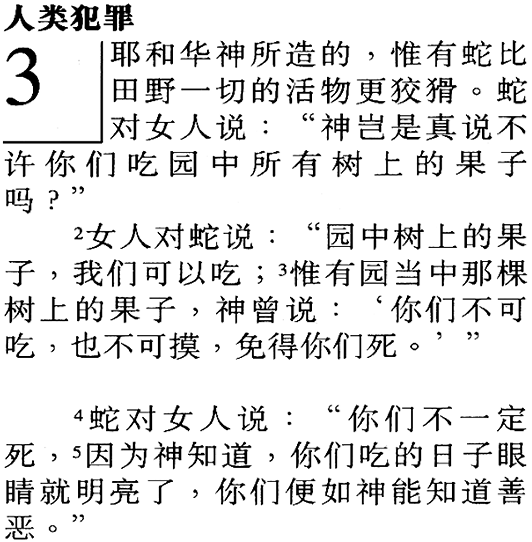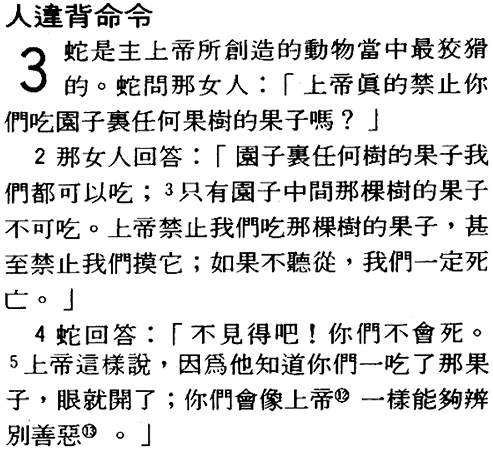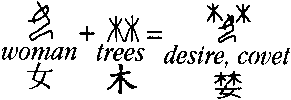 (shi / corpse)
(shi / corpse)The person had been cast out of heaven, away from the life-giving Creator God. The oracle bone character looks like a snake-like person, warped.
 (shi / corpse)
(shi / corpse)
The person had been cast out of heaven, away from the life-giving Creator God.
The oracle bone character looks like a snake-like person, warped.
 (ji / oneself)
(ji / oneself)
He was interested only in himself.
 (gong / bow, bow-shaped)
(gong / bow, bow-shaped)
He came to kill, symbolized by the bow.
 (fu / not)
(fu / not)
He came as a serpent wrapping around the two special trees. The resulting
Chinese character, now showing only the tree trunks, expresses a very negative
situation.
 (fei / not)
(fei / not)
In a similar character with the same negative meaning, the serpent has faded
from view somewhat. The oracle bone character shows two persons back to back
and two hands reaching up. The bronzeware character shows two hands back to
back, fingers pointing outward.
 (yi / kill, tear down, exterminate)
(yi / kill, tear down, exterminate)
Though Dr. Nelson's English associations may not be literal, the intent matches
the situation. A big, important, noble person is overshadowed by the serpent,
as clearly seen in the modern character. The deception begins with a distortion
of God's simple command.
Dr. Nelson interprets a simple vertical line in oracle bone characters as
indicating perfect, complete, though it received a horizontal addition in
modern characters to become the symbol for ten. With that in mind, this
modern character looks like the serpent beside a perfect person, similarly to
the previous oracle bone character for kill.
 (yin / lure, attract, quote, cite, lead, pull), which is
what the serpent then proceded to do.
(yin / lure, attract, quote, cite, lead, pull), which is
what the serpent then proceded to do.
Genesis 3:1-5
Now the serpent was more crafty than any of the wild animals the Lord God had
made. He said to the woman, "Did God really say, 'You must not eat from any
tree in the garden'?" The woman said to the serpent, "We may eat fruit from the
trees in the garden, but God did say, 'You must not eat fruit from the tree that
is in the middle of the garden, and you must not touch it, or you will die.'"
"You will not surely die," the serpent said to the woman. "For God knows that
when you eat of it your eyes will be opened, and you will be like God, knowing
good and evil." NIV
Now the snake was the most cunning animal that the Lord God had made. The snake
asked the woman, "Did God really tell you not to eat fruit from any tree in
the garden?" "We may eat the fruit of any tree in the garden," the woman answered,
"except the tree in the middle of it. God told us not to eat the fruit of that
tree or even touch it; if we do, we will die." The snake replied, "That's not
true; you will not die. God said that because he knows that when you eat it,
you will be like God and know what is good and what is bad." TEV
 U
U
 T
T
 (jie / warn, avoid)
(jie / warn, avoid)
God had warned the first people to refrain from reaching up for the fruit of
the wrong tree.
 (shu / restrain, bind)
(shu / restrain, bind)
A mouth in a tree is now a reminder of God's command not to eat from the
wrong tree.
 (lan / covetous, greedy)
(lan / covetous, greedy)
The woman was looking at the wrong tree and desiring its forbidden fruit.
Genesis 3:6
When the woman saw that the fruit of the tree was good for food and pleasing
to the eye, and also desirable for gaining wisdom, she took some and ate it.
She also gave some to her husband, who was with her, and he ate it. NIV
The woman saw how beautiful the tree was and how good its fruit would be to
eat, and she thought how wonderful it would be to become wise. So she took some
of the fruit and ate it. Then she gave some to her husband, and he also ate it.
TEV
 U
U
 T
T
In the character  (shi / beginning, start) we see the
component characters for a woman and a mouth for a particular private, secret
act of disobedience which changed history. It was the beginning of sin. The
woman's role of eating the wrong fruit is preserved in the character for
beginning.
(shi / beginning, start) we see the
component characters for a woman and a mouth for a particular private, secret
act of disobedience which changed history. It was the beginning of sin. The
woman's role of eating the wrong fruit is preserved in the character for
beginning.
Back, Next
Beginning,
Oracle Bones,
God,
Water,
Earth,
Mankind,
Adam,
Eve,
Good Tree,
Bad Tree,
Penalty,
Clothes,
Lamb,
Gate,
Murder,
Flood,
Lifespans,
Scattering,
Border Sacrifice,
Genesis 1 to 11